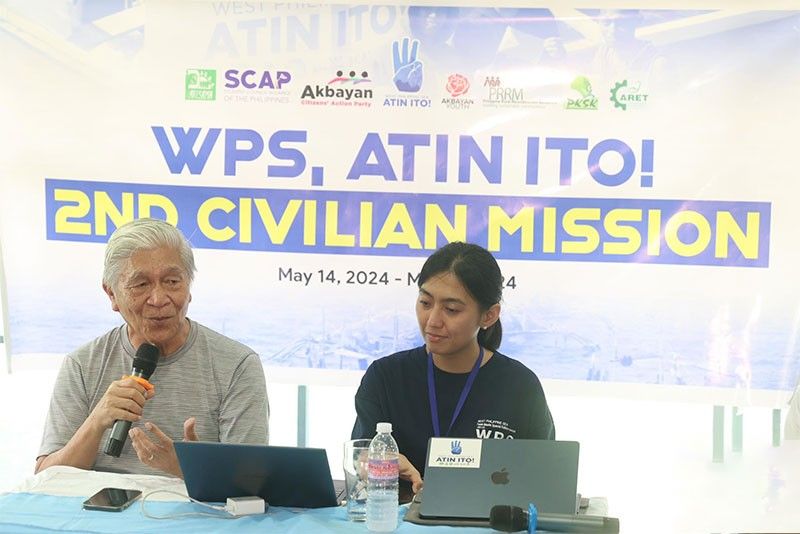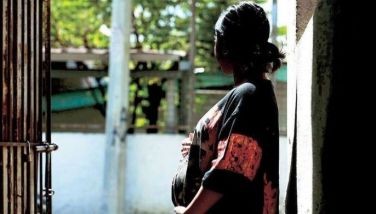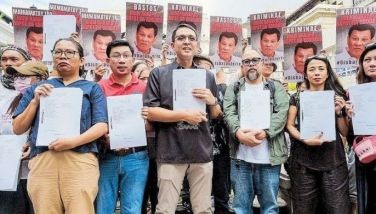Navy ship to monitor ‘Atin Ito’ regatta

MANILA, Philippines — The Philippine Navy is deploying a ship to monitor some 100 Filipino fishing boats and other civilian vessels en route to Panatag (Scarborough) Shoal as part of the “peace and solidarity regatta” organized by the Atin Ito Coalition.
The military did not reveal details of the deployment, like which ship is involved or where it intends to take position.
The Navy also revealed it had deployed another vessel to Escoda (Sabina) Shoal to stop possible reclamation activities by the Chinese in the area.
“We would like to commend Atin Ito organizers. This is civil society showing that they understand the issue,” Philippine Navy spokesman for West Philippine Sea Commodore Roy Vincent Trinidad told reporters yesterday.
The Panatag-bound flotilla left Masinloc, Zambales yesterday. The trip is expected to culminate on May 17.
The trip was intended as a humanitarian mission for fishermen as well as a demonstration of Filipinos’ determination to protect the country’s territorial seas.
The convoy is loaded with food and provisions for fishermen who have to stay in the area for days – often harassed by the Chinese – so they could take home sufficient catch.
“It is not only a government approach but a whole of nation approach. China should respect civil society in exercising Philippine rights,” he said.
Trinidad said the Philippine Coast Guard (PCG) is also in close coordination with organizers of the trip to Panatag.
The latest Atin Ito endeavor was the second civilian-led mission to the West Philippine Sea, following the journey to Ayungin Shoal in December last year, also for humanitarian purposes.
China has reportedly increased its presence in the vicinity of Panatag Shoal, also called Bajo de Masinloc, in anticipation of the civilian convoy.
Under Navy’s watch
Trinidad also revealed the deployment of a naval vessel in the vicinity of Escoda Shoal where they noted “the unnatural, unusual presence of crushed corals,” possibly dumped by the Chinese to raise the elevation of the land feature and prepare it for reclamation.
“The coast guard has a regular presence there, Navy has increased its patrols in Escoda Shoal and for the past good number of days, we have had one warship stationed in the area,” he said.
“This is to ensure that whoever is doing that, we are not sure who is doing that, whoever is piling up their corals on Escoda Shoal, we will be able to expose their activities,” Trinidad said.
He explained that Escoda Shoal “is closer to mainland Palawan than Ayungin Shoal.”
“Ayungin is 20 nautical miles east of Mischief (Panganiban). Encode is around 35 nautical miles east of Ayungin,” he said.
“So it is much much closer to mainland Palawan, well within the exclusive economic zone of the Philippines. We would like to ensure that this will remain within the sovereign rights of the country, hence the PCG and the Philippine Navy are taking cognizance of that, of the unusual pile up of dead corals,” he said.
Trinidad noted that back in 2011 and 2012, China did all major reclamation work in the WPS using giant dredgers to move sand to reclaim Panganiban, Zamora (Subi) and Calderon (Cuarteron) Reef.
“They were able to build military bases there. This time around, there was no noticed presence of those dredgers but we saw the result, a lot of crushed corals so as if, that Escoda Shoal is growing. So we could say this is one particular attempt to reclaim, to build up an artificial island. But we are on top of the situation. The coast guard is there, the Navy is there, we would like to prevent a repeat of what happened in 2012, 2013,” he said.
Trinidad said stopping possible reclamation activities in Escoda Shoal would take more than military effort and one way is to show the world “that we are a responsible player following international law.”
“The approach of the government in WPS is the transparency initiative. So we would like to show the world what the other players are doing in the maritime domain and I would like to say that the other claimant countries have been subscribing to international law, except for China,” he added.
Public support
National Security Adviser Eduardo Año, for his part, said he was heartened by the overwhelming public support for peaceful but more assertive stance in the WPS problem, based on latest polls.
“Filipinos are a people of peace but at the same time, we know how to stand up for what is right, and for what is ours. Heeding our people’s call, the Marcos Jr. administration is determined to progressively build our defense capabilities to effectively deter any and every threat to our nation’s peace and security,” Año said.
“We thank the Filipino people for their support and they can be assured that, guided by the President, we will continue to assert our rights and push back against illegal, coercive, aggressive and deception tactics,” he added.
Citing results of the OCTA Research Tugon ng Masa survey for the first quarter of the year, Año said 73 percent of respondents want the government to prioritize military action as response to threats to the country’s territorial and sovereign rights.
“The Philippine government continues to push for peaceful, diplomatic means to resolve any dispute with other country. Simply put, war is not an instrument of our national policy. However, under international law, we have the inalienable right to defend our people, our territorial integrity and sovereign rights,” Año said.
Based on survey results, he said Filipinos apparently understand that “there can be no peace without security, and that there will be no security without peace.”
Año also noted the high percentage of public support for AFP modernization – at 68 percent.
He also appealed to the Senate and the House of Representatives to support all programs aimed at fast tracking AFP modernization in order to allow the institution to focus on territorial defense.
“We hope that Congress will continue to allocate the necessary funds to implement Horizon III of the Armed Forces modernization program which is critical in the implementation of the Comprehensive Archipelagic Defense Concept recently approved by the President,” he said.
Legal options on Escoda
Meanwhile, the Department of Justice (DOJ) said it is working with the Office of the Solicitor General (OSG) in exploring all legal options to hold the Chinese accountable before an international tribunal for the marine destruction in Escoda Shoal.
“The DOJ and OSG continue to coordinate and discuss the possible options and recommendations which will be submitted to the President as soon as it is done,” DOJ spokesman Mico Clavano said.
Solicitor General Menardo Guevarra said the OSG and other relevant agencies are “identifying and gathering competent evidence” to support a possible environmental damage case against China.
“Any legal action will have to be considered and determined by the national maritime council, who will then make the appropriate recommendation to the President,” Guevarra said in a text message.
Earlier, retired Supreme Court associate justice Antonio Carpio called for the filing of a case against China over the damage it has caused to the Philippines’ marine resources.
Carpio said an apparent reclamation work on Escoda Shoal could be a “precursor of an island building by China” and the putting up of an outpost near Recto (Reed) Bank, which is said to be rich in oil and gas deposits.
Apart from filing a case, PCG should also have a permanent presence in Escoda Shoal to prevent Beijing from building artificial islands in the area, he said.
China’s foreign ministry has dismissed the allegations as “groundless and pure rumor,” saying Manila has “deliberately smeared China and attempted to mislead the international community.”
In 2016, the Philippines won against China in an arbitral case filed before the Permanent Court of Arbitration based in The Hague. The ruling invalidated Beijing’s nine-dash line claim that covered almost the entire South China Sea. China has refused to acknowledge the ruling. — Daphne Galvez
- Latest
- Trending































